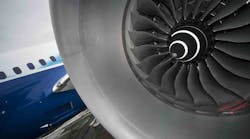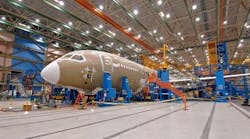For some, the goal is to increase uptime by reducing potential sources of downtime.
A special fixture (below) holds an automotive valve body for machining the Zsurface or large joint face. The fixture is used at both the rough and finish-mill stations on a free transfer line (above) jointly developed by Ford and Kingsbury.
A second, more recent transfer line from Kingsbury completes spool bores, both roughing and finishing, at a single, 3-axis CNC station by automatically changing tools. The line is palletized (at right), but pallets are symmetrical to accommodate two different styles of Ford valve bodies.
When Ford sat down with Kingsbury to discuss new transfer line projects, there was no mention of decreasing cycle times. Jack Birdsong, senior process engineer at Ford's Sharonville, Ohio, plant says his only intent was to improve uptime for two existing part-manufacturing processes. To accomplish this, Ford—working with Kingsbury, a machine-tool company in Keene, N.H.—eliminated potential downtime by lessening the number of process stages and engineering problem areas from two new transfer lines.
The success of the first project hinged on free part transfer. In free transfer, which is nothing new, parts are clamped (for a machining operation), then unclamped (for transfer to the next station), clamped again (for the next machining operation), and so on down the line until the part is complete. This type of line moves parts using features of the workpiece it-self, instead of multiple pallets. "There aren't many companies that build free transfer (non-palletized) lines," says Randy Lavigne of Kingsbury, "but it's a niche we've had in the market." Although how Ford wanted to use free transfer was a first for Kingsbury.
What sets the Ford line apart, explains Birdsong, is that it diamond mills and drills automotive valve bodies using free transfer. "Other plants have tried to diamond mill," he says, "but did it in fixturized-type operations that couldn't relieve part stress."
Rough milling the valve bodies creates stored energy in the part. Unclamping afterwards releases these detrimental forces that can flex, bend, or move the part prior to a crucial finishing operation. With free transfer, the new line diamond mills parts so flat that Ford no longer does a final surface lapping.
"The final lapping process was a pain," says Birdsong. "To hold part flatness to within 0.001 in. meant constant wheel dressing. Each operator had his own technique, so dressing wasn't consistent. Some days we would get 300 parts/dress and other days only 50/dress."
To marry diamond milling together with free transfer, Ford and Kingsbury designed a special hydraulic clamping system. It rigidly holds the part's periphery with controlled pressure that also prevents bending or twisting of the part. This regulated hydraulic pressure secures parts for removing 0.060 to 0.070 in. of stock off two sides, and then loosens its grip for stress relief and transfer.
A team comprised of Sharonville and Kingsbury personnel determined that existing, in-house Sandvik cutters would work on the new line for swallow milling both the rough and finish passes. These 14-in. diameter diamond cutters rough mill Z surfaces of the 8 3 11-in. valve bodies and, with half the inserts removed, can also be used at the finish-mill station. Birdsong says the plant used diamond milling before but could not reap its full benefits until the switch to free transfer and a conversion to water soluble coolant throughout the transfer line.
The old line milled, drilled, gun reamed, then removed the part and transported it, via monorail, to a parts washer. Parts needed cleaning before being lapped because that process used a coolant different from that of the transfer line's.
Water soluble coolant gives Ford better surface finishes with its diamond tooling, while free part transfer enables the automaker to produce a flat surface. This means Ford can ream the valve body's eight bores at the next operation without part distortion. And because parts are free of residual forces, the line can take off 0.040 in. at the beginning of a hole and as much as 0.085 in. at the full hole depth without affecting the part. Eliminating the final lapping process and converting to water soluble coolant also allowed Ford to do away with a few other wash and stock-removal operations. The Kingsbury line completes an as-cast valve body in three operations, as opposed to the old line's seven operations. That's four less potential sources of downtime, remarks Birdsong.
Because the free transfer project was a success, Ford again teamed up with Kingsbury to build a palletized transfer line with less potential downtime. This line does both 4R70W and 5R55N valve bodies—one is for a 4-speed rear-wheel drive transmission, the other a 5-speed. Line changeover time between the two parts is under four hours.
This new line uses stub tooling, again nothing new, but a real reduction in downtime, says Bird-song. Stub tooling involves making boring tools as short as possible and running them in a rigid holder and spindle. These shorter tools have less chance of bending as compared to longer ones. With stub tooling, manufacturers can ream holes, change tools, and finish cut with little possibility of tool deflection. Prior downtime came from having to keep bushings and nose cones aligned with feed-out spindles.
Added controls on the Kingsbury line regulate/adjust stub tooling rpm to match the amount of stock being removed. This keeps tool pressure in check and eliminates the need for bushings and nose cones.
"Being comfortable using stub tooling gave us [Ford and Kingsbury] the confidence to incorporate tool changing into this second line," says Birdsong. "That's the one thing that gave it the flexibility to do both 4R and 5R valve bodies."
Basically, the line has a GE Fanuc control that stops the spindle in the time needed to change tools. The line is a first because it completes spool bores, both roughing and finishing, at a single, 3-axis CNC station that automatically changes tools.
As in traditional systems, the line is palletized, but pallets are symmetrical, holding 4Rs on one side and 5Rs on the other. Bird-song points out that these parts are quite different, and the line is flexible enough to handle the 11 bores in the rectangular-shaped 4Rs and the 17 bores in the irregular-shaped 5Rs.










